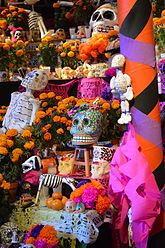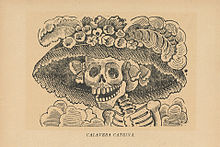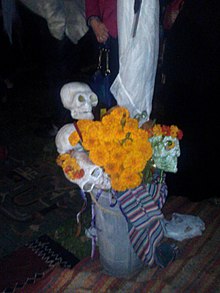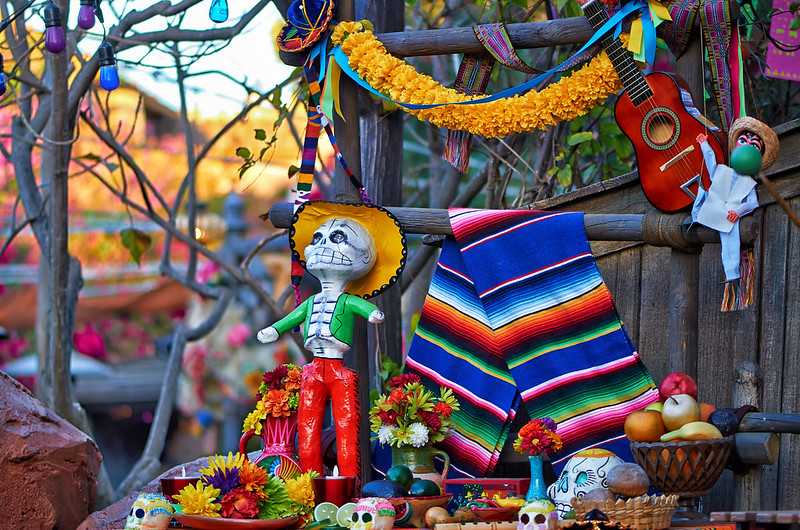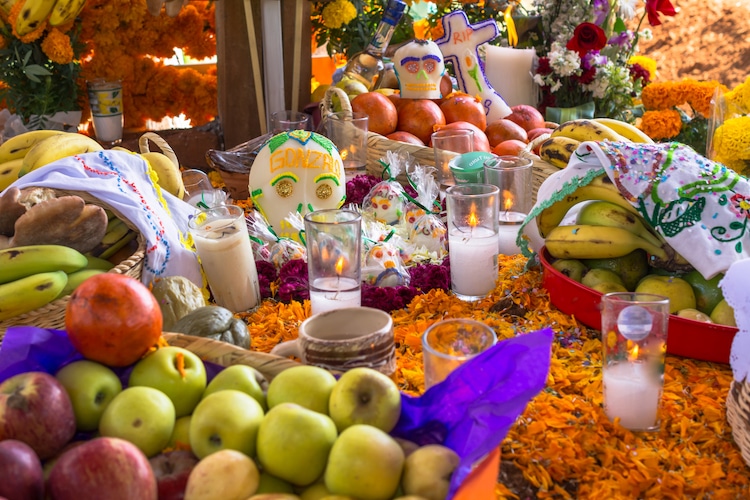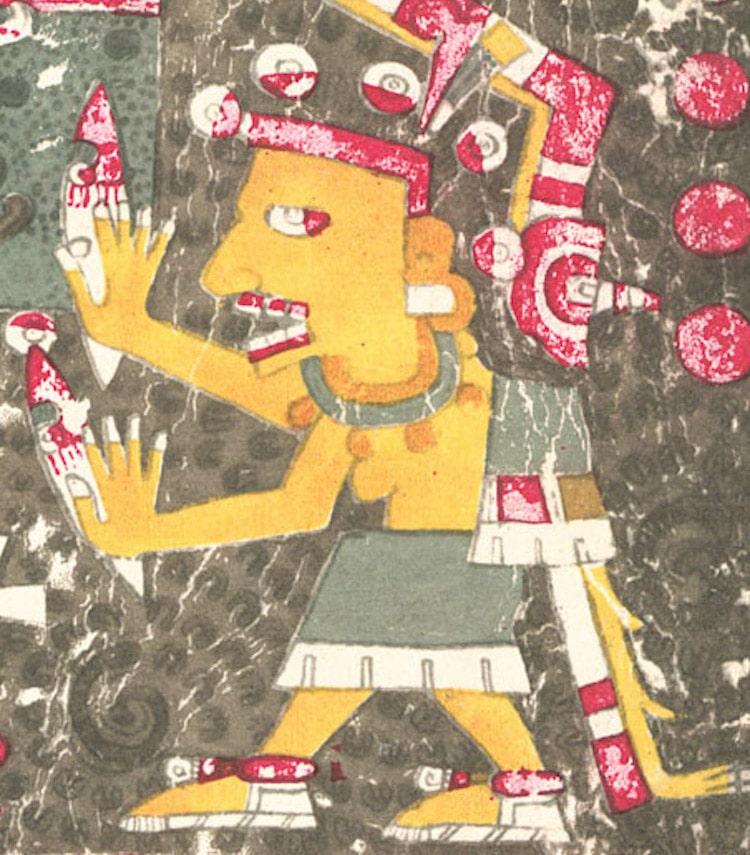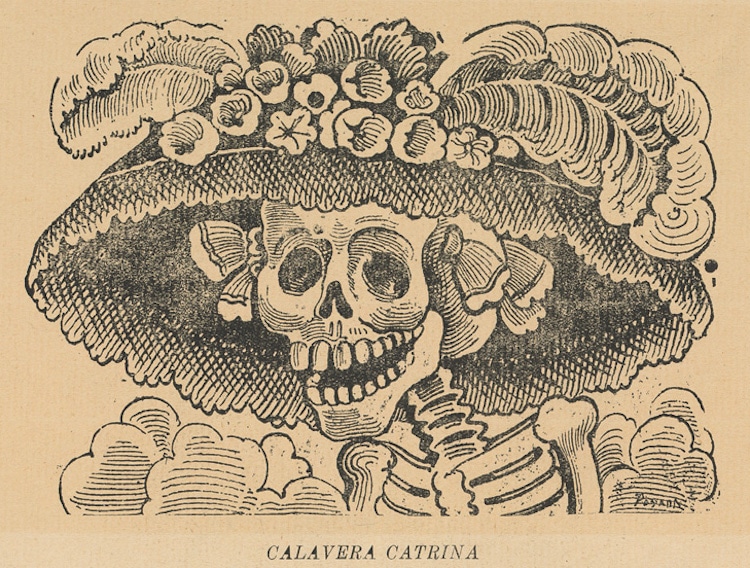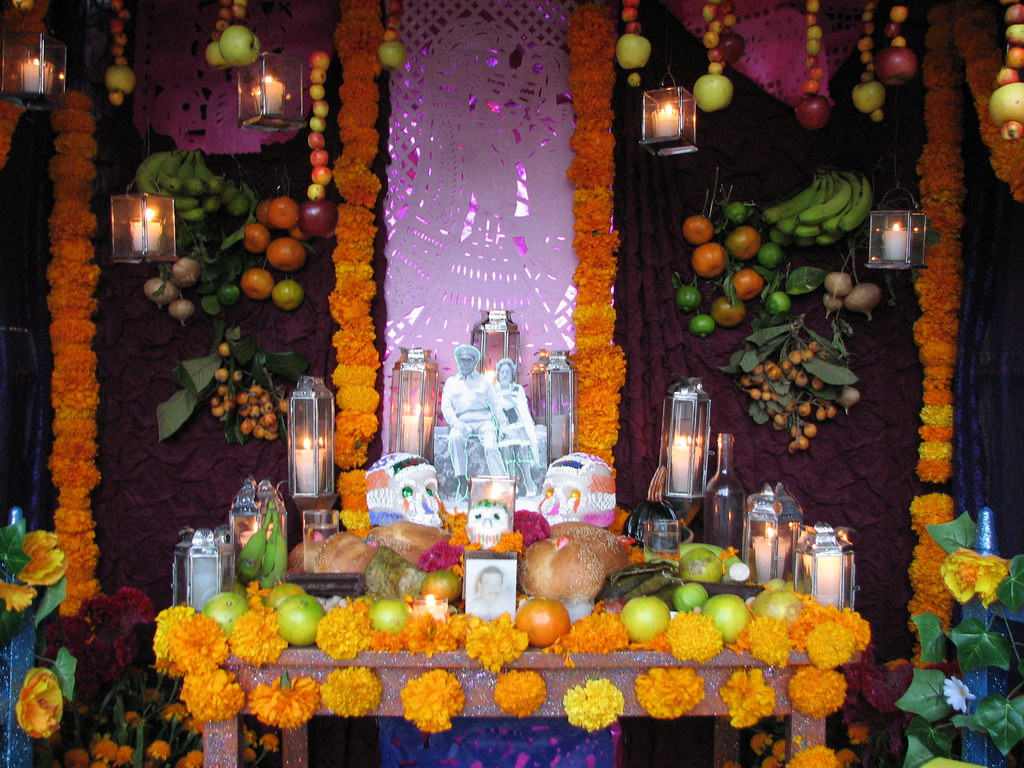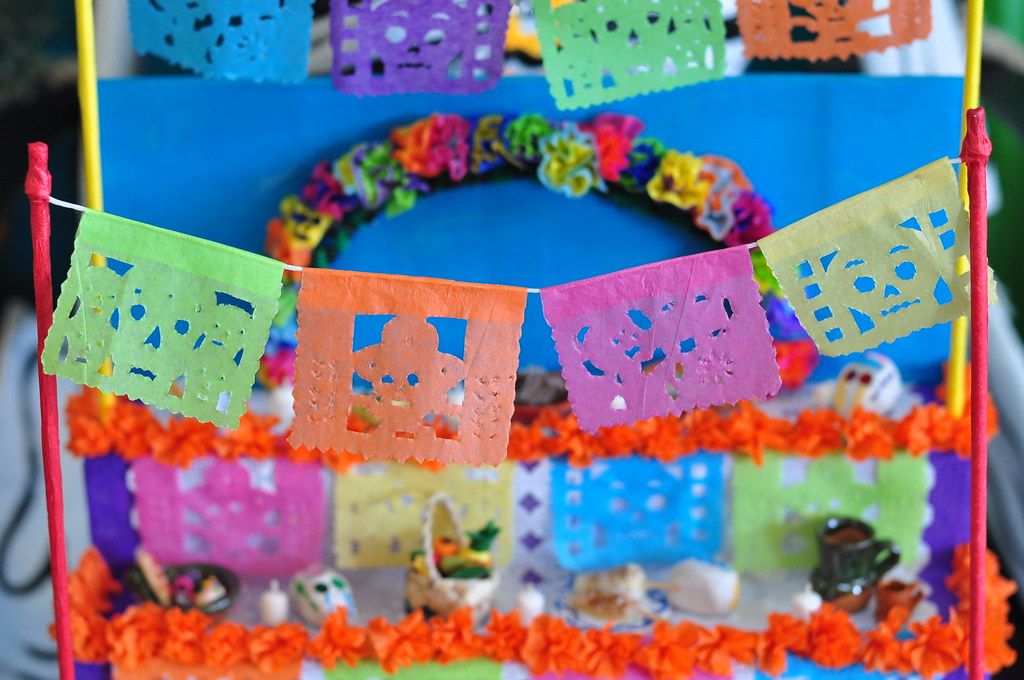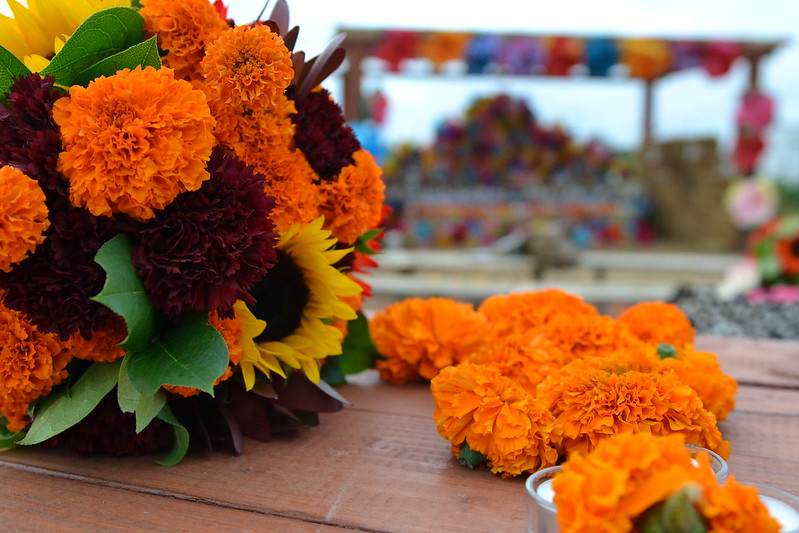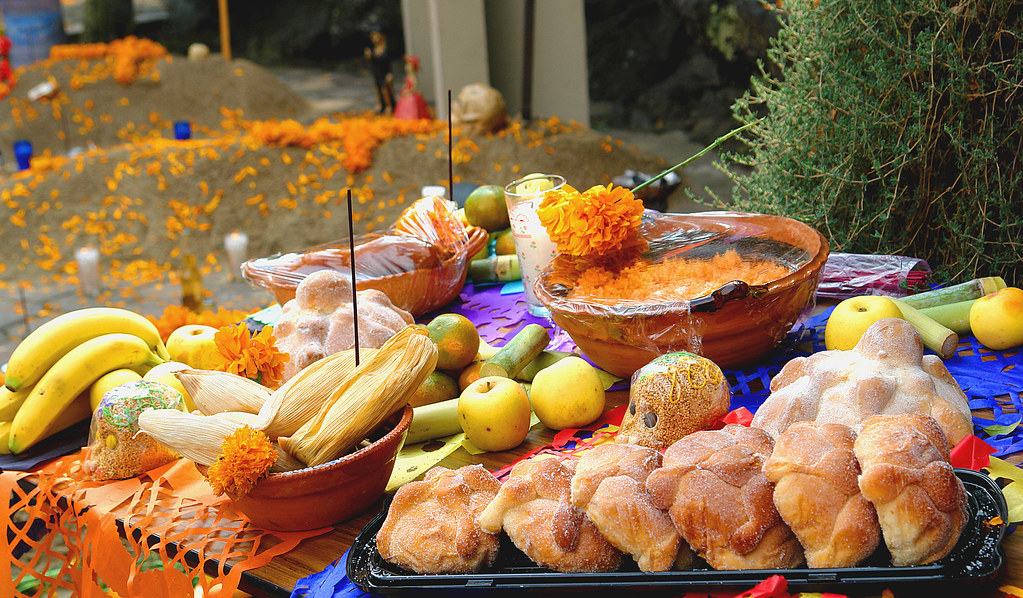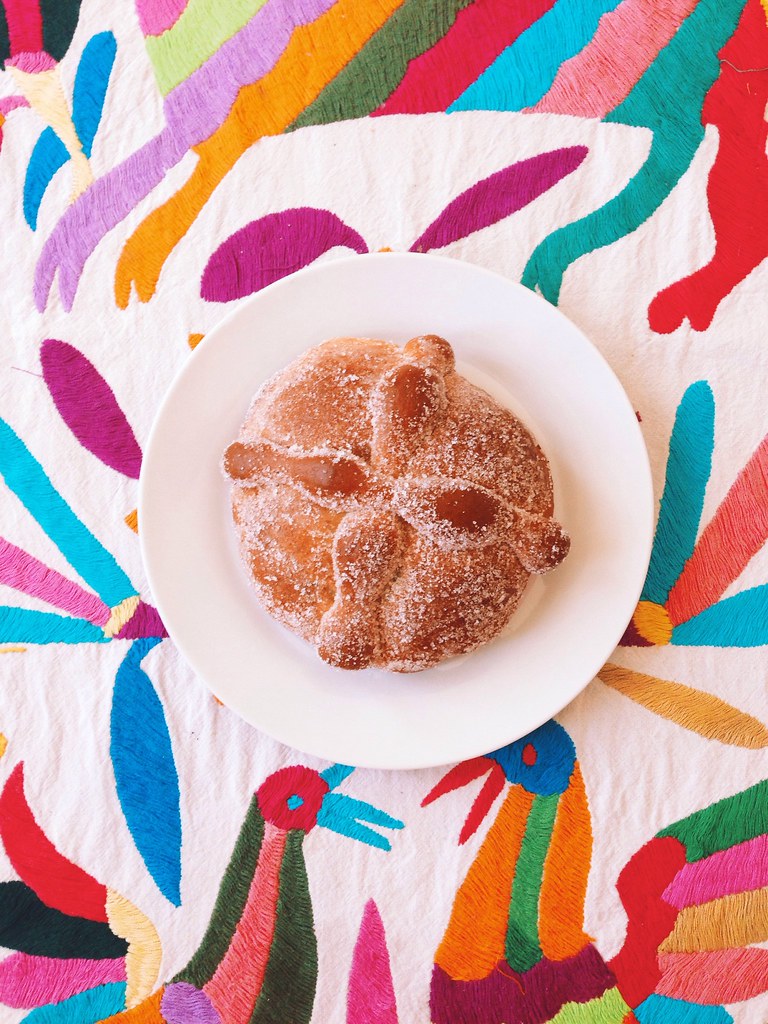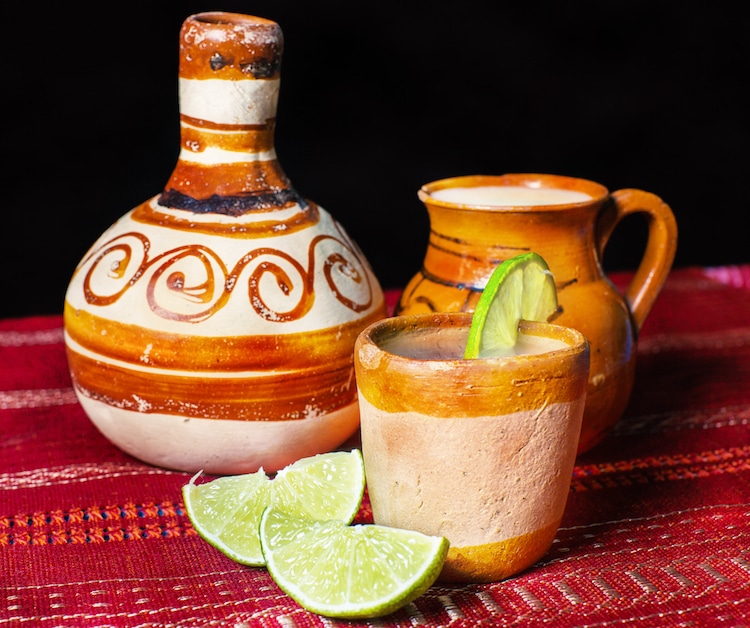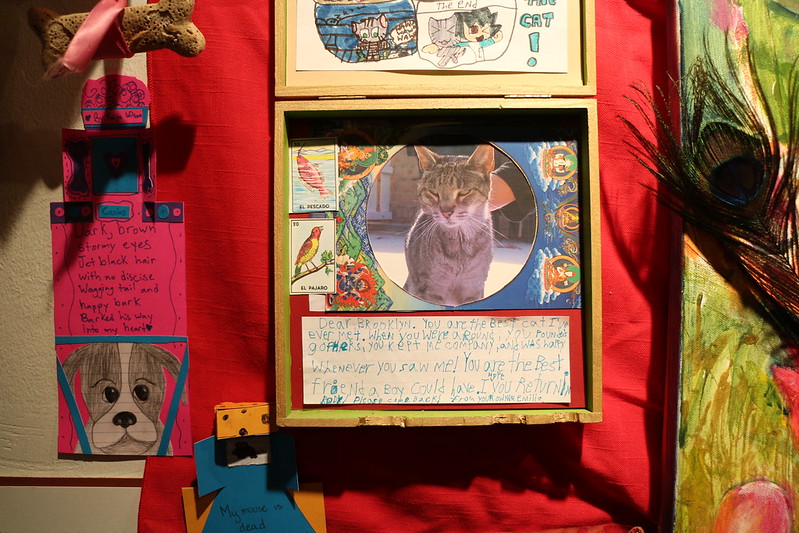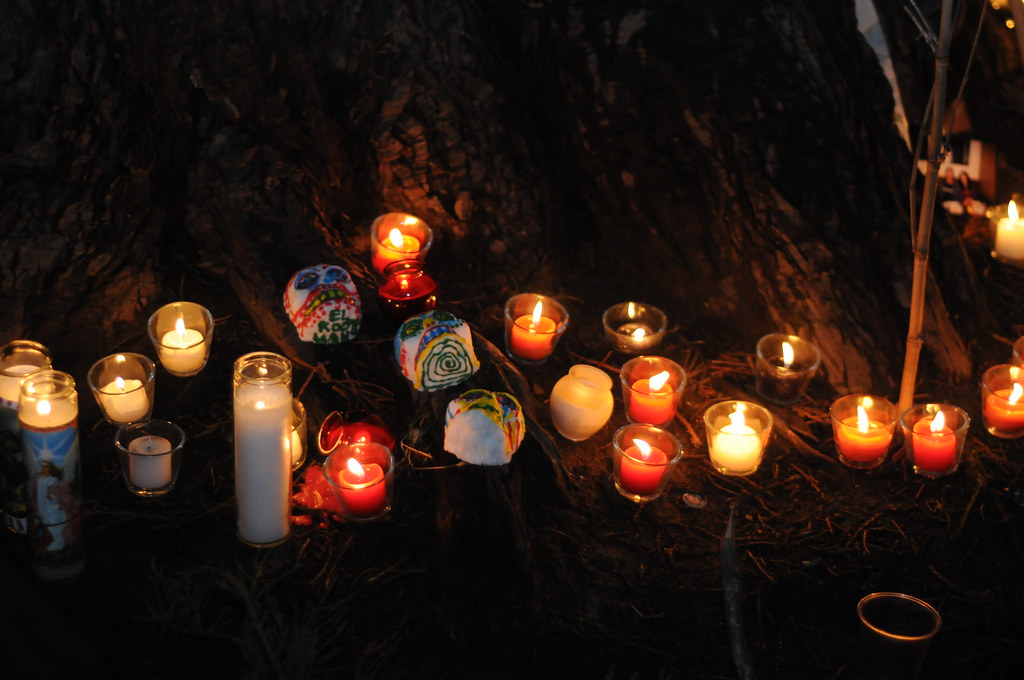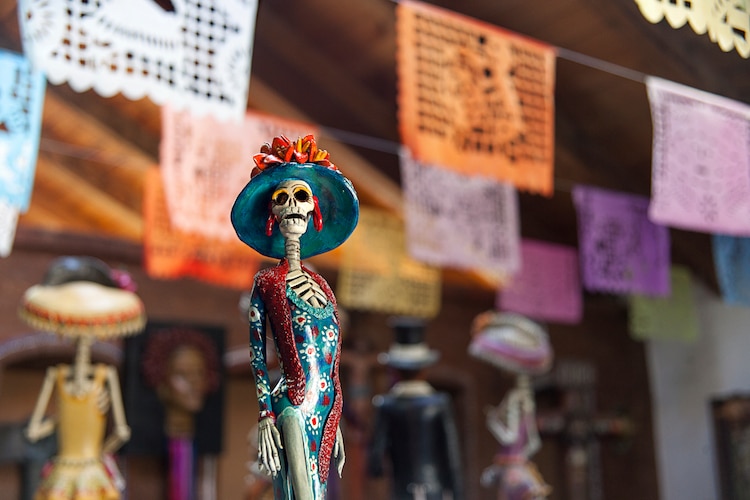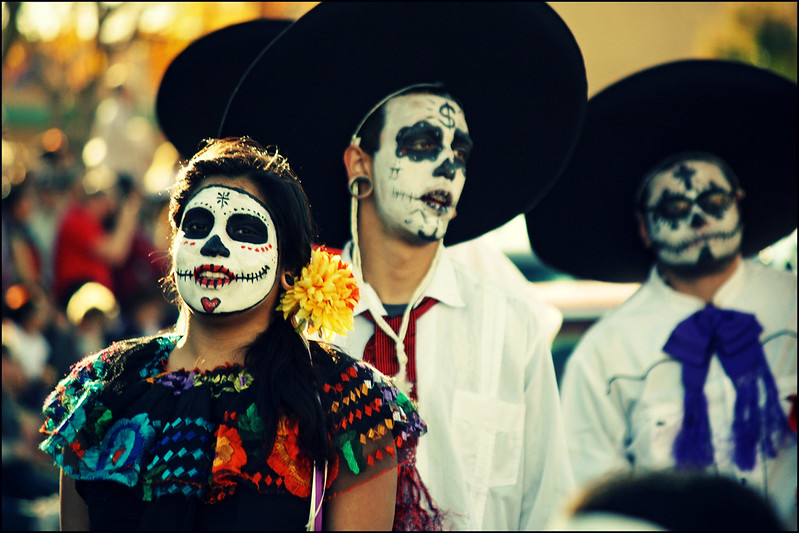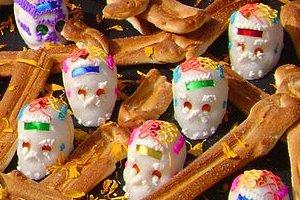Day of the Dead (known as Día de Muertos in Spanish) is celebrated in Mexico between October 31st and November 2nd. On this holiday, Mexicans remember and honor their deceased loved ones. It’s not a gloomy or morbid occasion, rather it is a festive and colorful holiday celebrating the lives of those who have passed on. Mexicans visit cemeteries, decorate the graves and spend time there, in the presence of their deceased friends and family members. They also make elaborately decorated altars (called ofrendas) in their homes to welcome the spirits.
Because of its importance as a defining aspect of Mexican culture and the unique aspects of the celebration which have been passed down through generations, Mexico’s indigenous festivity dedicated to the dead was recognized by UNESCO as part of the intangible cultural heritage of humanity in 2008.
History of the Holiday
In Pre-Hispanic times, the dead were buried close to family homes (often in a tomb underneath the central patio of the house) and there was great emphasis on maintaining ties with deceased ancestors, who were believed to continue to exist on a different plane. With the arrival of the Spaniards and Catholicism, All Souls’ and All Saints’ Day practices were incorporated into Pre-Hispanic beliefs and customs and the holiday came to be celebrated as we know it today.
The belief behind Day of the Dead practices is that spirits return to the world of the living for one day of the year to be with their families. It is said that the spirits of babies and children who have died (called angelitos, «little angels») arrive on October 31st at midnight, spend an entire day with their families and then leave. Adults come the following day. Learn more about the origins of the holiday.
Food Associated With the Holiday
The spirits are greeted with offerings of special foods and things that they enjoyed when they were alive. These are laid out on an altar in the family home. It is believed that the spirits consume the essence and the aroma of the foods that are offered. When the spirits depart, the living consumes the food and share it with their family, friends, and neighbors.
Other items that are placed on the altar include sugar skulls, often with the person’s name inscribed on the top, pan de muertos, a special bread that is made especially for the season, and cempasuchil (marigolds) which bloom at this time of year and lend a special fragrance to the altar.
How Day of the Dead Is Celebrated
In ancient times, people were buried close to their family homes and there was no need to have separate grave decorations and home altars, these were together in one place. Now that the dead are buried away from their homes, graves are decorated with the idea that the dead return there first. In some villages, flower petals are laid in paths from the cemetery to the home so that the spirits will be able to find their way. In some communities, it is customary to spend the whole night in the cemetery, and people make a party of it, having a picnic supper, playing music, talking and drinking through the night.
Day of the Dead is celebrated in different ways in different locations throughout Mexico. Festivities tend to be more colorful in the southern region, particularly in the states of Michoacan, Oaxaca, and Chiapas. In rural areas, celebrations are mostly solemn whereas in bigger cities they are sometimes irreverent. There are a few destinations that are well-known for their observances, and there are often special tours and activities that offer glimpses into local practices such as Mexico Underground’s Day of the Dead Tour in Mexico City or Wayak’s Day of the Dead Tour.
Differences Between Day of the Dead and Halloween
Day of the Dead and Halloween have some common features, but they are distinct holidays. They both come from early cultures’ beliefs about death that later mixed with Christianity. They are both based on the idea that the spirits return at that time of year. Customs around Halloween seem to stem from the idea that the spirits were malevolent (children were disguised so that they wouldn’t be harmed), whereas in Day of the Dead festivities, the spirits are joyfully welcomed as family members that one hasn’t seen in a year.
Day of the Dead continues to change, and a mixing of cultures and customs continues to occur. Halloween festivities are becoming more prevalent in Mexico: masks and costumes are sold in the markets alongside sugar skulls and pan de muertos, costume contests are held along with altar contests in schools, and some children dress up in costumes and go trick-or-treating («pedir muertos»).
How to Visit Mexico For Day of the Dead
This holiday is an excellent time to visit Mexico. Not only will you be able to witness these special celebrations, but you can also enjoy other advantages of Mexico in the fall. Although families celebrate this holiday privately, there are many public displays that you can enjoy, and if you act respectfully, no one will mind your presence in the cemeteries and other public spaces where Mexicans celebrate and honor their deceased.
You can also visit Day of the Dead destinations to have the most memorable experience. Of course, if you can’t make it to Mexico, you can still celebrate the holiday by making your own altar to honor your loved ones who have passed on.
| Day of the Dead | |
|---|---|
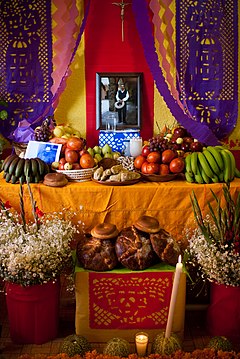
Día de Muertos altar commemorating a deceased man in Milpa Alta, Mexico City |
|
| Observed by | Mexico, and regions with large Mexican populations |
| Type |
|
| Significance | Prayer and remembrance of friends and family members who have died |
| Celebrations | Creation of home altars to remember the dead, traditional dishes for the Day of the Dead |
| Begins | November 1 |
| Ends | November 2 |
| Date | November 2 |
| Next time | 2 November 2023 |
| Frequency | Annual |
| Related to | All Saints’ Day, All Hallows’ Eve, All Souls Day[1] |
The Day of the Dead (Spanish: Día de Muertos or Día de los Muertos)[2][3] is a holiday traditionally celebrated on November 1 and 2, though other days, such as October 31 or November 6, may be included depending on the locality.[4][5][6] It is widely observed in Mexico, where it largely developed, and is also observed in other places, especially by people of Mexican heritage. Although related to the simultaneous Christian remembrances for Hallowtide,[1] it has a much less solemn tone and is portrayed as a holiday of joyful celebration rather than mourning.[7] The multi-day holiday involves family and friends gathering to pay respects and to remember friends and family members who have died. These celebrations can take a humorous tone, as celebrants remember funny events and anecdotes about the departed.[8]
Traditions connected with the holiday include honoring the deceased using calaveras and marigold flowers known as cempazúchitl, building home altars called ofrendas with the favorite foods and beverages of the departed, and visiting graves with these items as gifts for the deceased.[9] The celebration is not solely focused on the dead, as it is also common to give gifts to friends such as candy sugar skulls, to share traditional pan de muerto with family and friends, and to write light-hearted and often irreverent verses in the form of mock epitaphs dedicated to living friends and acquaintances, a literary form known as calaveras literarias.[10]
In 2008, the tradition was inscribed in the Representative List of the Intangible Cultural Heritage of Humanity by UNESCO.[11]
Origins, history, and similarities to other festivities
Mexican academics are divided on whether the festivity has genuine indigenous pre-Hispanic roots or whether it is a 20th-century rebranded version of a Spanish tradition developed during the presidency of Lázaro Cárdenas to encourage Mexican nationalism through an «Aztec» identity.[12][13][14] The festivity has become a national symbol in recent decades and it is taught in the nation’s school system asserting a native origin.[15] In 2008, the tradition was inscribed in the Representative List of the Intangible Cultural Heritage of Humanity by UNESCO.[11]
Views differ on whether the festivity has indigenous pre-Hispanic roots, whether it is a more modern adaptation of an existing European tradition, or a combination of both as a manifestation of syncretism. Similar traditions can be traced back to Medieval Europe, where celebrations like All Saints’ Day and All Souls’ Day are observed on the same days in places like Spain and Southern Europe. Critics of the native American origin claim that even though pre-Columbian Mexico had traditions that honored the dead, current depictions of the festivity have more in common with European traditions of Danse macabre and their allegories of life and death personified in the human skeleton to remind us the ephemeral nature of life.[16][12] Over the past decades, however, Mexican academia has increasingly questioned the validity of this assumption, even going as far as calling it a politically motivated fabrication. Historian Elsa Malvido, researcher for the Mexican INAH and founder of the institute’s Taller de Estudios sobre la Muerte, was the first to do so in the context of her wider research into Mexican attitudes to death and disease across the centuries. Malvido completely discards a native or even syncretic origin arguing that the tradition can be fully traced to Medieval Europe. She highlights the existence of similar traditions on the same day, not just in Spain, but in the rest of Catholic Southern Europe and Latin America such as altars for the dead, sweets in the shape of skulls and bread in the shape of bones.[16]
Agustin Sanchez Gonzalez has a similar view in his article published in the INAH’s bi-monthly journal Arqueología Mexicana. Gonzalez states that, even though the «indigenous» narrative became hegemonic, the spirit of the festivity has far more in common with European traditions of Danse macabre and their allegories of life and death personified in the human skeleton to remind us the ephemeral nature of life. He also highlights that in the 19th century press there was little mention of the Day of the Dead in the sense that we know it today. All there was were long processions to cemeteries, sometimes ending with drunkenness. Elsa Malvido also points to the recent origin of the tradition of «velar» or staying up all night with the dead. It resulted from the Reform Laws under the presidency of Benito Juarez which forced family pantheons out of Churches and into civil cemeteries, requiring rich families having servants guarding family possessions displayed at altars.[16]
The historian Ricardo Pérez Montfort has further demonstrated how the ideology known as indigenismo became more and more closely linked to post-revolutionary official projects whereas Hispanismo was identified with conservative political stances. This exclusive nationalism began to displace all other cultural perspectives to the point that in the 1930s, the Aztec god Quetzalcoatl was officially promoted by the government as a substitute for the Spanish Three Kings tradition, with a person dressed up as the deity offering gifts to poor children.[12]
In this context, the Day of the Dead began to be officially isolated from the Catholic Church by the leftist government of Lázaro Cárdenas motivated both by «indigenismo» and left-leaning anti-clericalism. Malvido herself goes as far as calling the festivity a «Cardenist invention» whereby the Catholic elements are removed and emphasis is laid on indigenous iconography, the focus on death and what Malvido considers to be the cultural invention according to which Mexicans venerate death.[14][17] Gonzalez explains that Mexican nationalism developed diverse cultural expressions with a seal of tradition but which are essentially social constructs which eventually developed ancestral tones. One of these would be the Catholic Día de Muertos which, during the 20th century, appropriated the elements of an ancient pagan rite.[12]
One key element of the re-developed festivity which appears during this time is La Calavera Catrina by Mexican lithographer José Guadalupe Posada. According to Gonzalez, whereas Posada is portrayed in current times as the «restorer» of Mexico’s pre-Hispanic tradition he was never interested in Native American culture or history. Posada was predominantly interested in drawing scary images which are far closer to those of the European renaissance or the horrors painted by Francisco de Goya in the Spanish war of Independence against Napoleon than the Mexica tzompantli. The recent trans-atlantic connection can also be observed in the pervasive use of couplet in allegories of death and the play Don Juan Tenorio by 19th Spanish writer José Zorrilla which is represented on this date both in Spain and in Mexico since the early 19th century due to its ghostly apparitions and cemetery scenes.[12]
Opposing views assert that despite the obvious European influence, there exists proof of pre-Columbian festivities that were very similar in spirit, with the Aztec people having at least six celebrations during the year that were very similar to Day of the Dead, the closest one being Quecholli, a celebration that honored Mixcóatl (the god of war) and was celebrated between October 20 and November 8. This celebration included elements such as the placement of altars with food (tamales) near the burying grounds of warriors to help them in their journey to the afterlife.[13] Influential Mexican poet and Nobel prize laureate Octavio Paz strongly supported the syncretic view of the Día de Muertos tradition being a continuity of ancient Aztec festivals celebrating death, as is most evident in the chapter «All Saints, Day of the Dead» of his 1950 book-length essay The Labyrinth of Solitude.[18]
Regardless of its origin, the festivity has become a national symbol in Mexico and as such is taught in the nation’s school system, typically asserting a native origin. It is also a school holiday nationwide.[15]
Observance in Mexico
Altars (ofrendas)
During Día de Muertos, the tradition is to build private altars («ofrendas») containing the favorite foods and beverages, as well as photos and memorabilia, of the departed. The intent is to encourage visits by the souls, so the souls will hear the prayers and the words of the living directed to them. These altars are often placed at home or in public spaces such as schools and libraries, but it is also common for people to go to cemeteries to place these altars next to the tombs of the departed.[8]
Mexican cempasúchil (marigold) is the traditional flower used to honor the dead.
Plans for the day are made throughout the year, including gathering the goods to be offered to the dead. During the three-day period families usually clean and decorate graves;[19] most visit the cemeteries where their loved ones are buried and decorate their graves with ofrendas (altars), which often include orange Mexican marigolds (Tagetes erecta) called cempasúchil (originally named cempōhualxōchitl, Nāhuatl for ‘twenty flowers’). In modern Mexico the marigold is sometimes called Flor de Muerto (‘Flower of Dead’). These flowers are thought to attract souls of the dead to the offerings. It is also believed the bright petals with a strong scent can guide the souls from cemeteries to their family homes.[20][21]
Toys are brought for dead children (los angelitos, or ‘the little angels’), and bottles of tequila, mezcal or pulque or jars of atole for adults. Families will also offer trinkets or the deceased’s favorite candies on the grave. Some families have ofrendas in homes, usually with foods such as candied pumpkin, pan de muerto (‘bread of dead’), and sugar skulls; and beverages such as atole. The ofrendas are left out in the homes as a welcoming gesture for the deceased.[19][21] Some people believe the spirits of the dead eat the «spiritual essence» of the ofrendas‘ food, so though the celebrators eat the food after the festivities, they believe it lacks nutritional value. Pillows and blankets are left out so the deceased can rest after their long journey. In some parts of Mexico, such as the towns of Mixquic, Pátzcuaro and Janitzio, people spend all night beside the graves of their relatives. In many places, people have picnics at the grave site, as well.
Some families build altars or small shrines in their homes;[19] these sometimes feature a Christian cross, statues or pictures of the Blessed Virgin Mary, pictures of deceased relatives and other people, scores of candles, and an ofrenda. Traditionally, families spend some time around the altar, praying and telling anecdotes about the deceased. In some locations, celebrants wear shells on their clothing, so when they dance, the noise will wake up the dead; some will also dress up as the deceased.
Food
During Day of the Dead festivities, food is both eaten by living people and given to the spirits of their departed ancestors as ofrendas (‘offerings’).[22] Tamales are one of the most common dishes prepared for this day for both purposes.[23]
Family altar for the Day of the Dead on a patio
Pan de muerto and calaveras are associated specifically with Day of the Dead. Pan de muerto is a type of sweet roll shaped like a bun, topped with sugar, and often decorated with bone-shaped pieces of the same pastry.[24] Calaveras, or sugar skulls, display colorful designs to represent the vitality and individual personality of the departed.[23]
In addition to food, drinks are also important to the tradition of Day of the Dead. Historically, the main alcoholic drink was pulque while today families will commonly drink the favorite beverage of their deceased ancestors.[23] Other drinks associated with the holiday are atole and champurrado, warm, thick, non-alcoholic masa drinks.
Agua de Jamaica (water of hibiscus) is a popular herbal tea made of the flowers and leaves of the Jamaican hibiscus plant (Hibiscus sabdariffa), known as flor de Jamaica in Mexico. It is served cold and quite sweet with a lot of ice. The ruby-red beverage is also known as hibiscus tea in English-speaking countries.[25]
In the Yucatán Peninsula, mukbil pollo (píib chicken) is traditionally prepared on October 31 or November 1, and eaten by the family throughout the following days. It is similar to a big tamale, composed of masa and pork lard, and stuffed with pork, chicken, tomato, garlic, peppers, onions, epazote, achiote, and spices. Once stuffed, the mukbil pollo is bathed in kool sauce, made with meat broth, habanero chili, and corn masa. It is then covered in banana leaves and steamed in an underground oven over the course of several hours. Once cooked, it is dug up and opened to eat.[26][27]
Calaveras
A common symbol of the holiday is the skull (in Spanish calavera), which celebrants represent in masks, called calacas (colloquial term for skeleton), and foods such as chocolate or sugar skulls, which are inscribed with the name of the recipient on the forehead. Sugar skulls can be given as gifts to both the living and the dead.[28] Other holiday foods include pan de muerto, a sweet egg bread made in various shapes from plain rounds to skulls, often decorated with white frosting to look like twisted bones.[21]
Calaverita
In some parts of the country, especially the larger cities, children in costumes roam the streets, knocking on people’s doors for a calaverita, a small gift of candies or money; they also ask passersby for it. This custom is similar to that of Halloween’s trick-or-treating in the United States, but without the component of mischief to homeowners if no treat is given.[29]
Calaveras literarias
A distinctive literary form exists within this holiday where people write short poems in traditional rhyming verse, called calaveras literarias (lit. «literary skulls»), which are mocking, light-hearted epitaphs mostly dedicated to friends, classmates, co-workers, or family members (living or dead) but also to public or historical figures, describing interesting habits and attitudes, as well as comedic or absurd anecdotes that use death-related imagery which includes but is not limited to cemeteries, skulls, or the grim reaper, all of this in situations where the dedicatee has an encounter with death itself.[30] This custom originated in the 18th or 19th century after a newspaper published a poem narrating a dream of a cemetery in the future which included the words «and all of us were dead», and then proceeding to read the tombstones. Current newspapers dedicate calaveras literarias to public figures, with cartoons of skeletons in the style of the famous calaveras of José Guadalupe Posada, a Mexican illustrator.[28] In modern Mexico, calaveras literarias are a staple of the holiday in many institutions and organizations, for example, in public schools, students are encouraged or required to write them as part of the language class.[10]
Posada created what might be his most famous print, he called the print La Calavera Catrina («The Elegant Skull») as a parody of a Mexican upper-class female. Posada’s intent with the image was to ridicule the others that would claim the culture of the Europeans over the culture of the indigenous people. The image was a skeleton with a big floppy hat decorated with two big feathers and multiple flowers on the top of the hat. Posada’s striking image of a costumed female with a skeleton face has become associated with the Day of the Dead, and Catrina figures often are a prominent part of modern Day of the Dead observances.[28]
Theatrical presentations of Don Juan Tenorio by José Zorrilla (1817–1893) are also traditional on this day.
Local traditions
The traditions and activities that take place in celebration of the Day of the Dead are not universal, often varying from town to town. For example, in the town of Pátzcuaro on the Lago de Pátzcuaro in Michoacán, the tradition is very different if the deceased is a child rather than an adult. On November 1 of the year after a child’s death, the godparents set a table in the parents’ home with sweets, fruits, pan de muerto, a cross, a rosary (used to ask the Virgin Mary to pray for them), and candles. This is meant to celebrate the child’s life, in respect and appreciation for the parents. There is also dancing with colorful costumes, often with skull-shaped masks and devil masks in the plaza or garden of the town. At midnight on November 2, the people light candles and ride winged boats called mariposas (butterflies) to Janitzio, an island in the middle of the lake where there is a cemetery, to honor and celebrate the lives of the dead there.
In contrast, the town of Ocotepec, north of Cuernavaca in the State of Morelos, opens its doors to visitors in exchange for veladoras (small wax candles) to show respect for the recently deceased. In return the visitors receive tamales and atole. This is done only by the owners of the house where someone in the household has died in the previous year. Many people of the surrounding areas arrive early to eat for free and enjoy the elaborate altars set up to receive the visitors.
Another peculiar tradition involving children is La Danza de los Viejitos (the Dance of the Old Men) where boys and young men dressed like grandfathers crouch and jump in an energetic dance.[31]
In the 2015 James Bond film Spectre, the opening sequence features a Day of the Dead parade in Mexico City. At the time, no such parade took place in Mexico City; one year later, due to the interest in the film and the government desire to promote the Mexican culture, the federal and local authorities decided to organize an actual Día de Muertos parade through Paseo de la Reforma and Centro Historico on October 29, 2016, which was attended by 250,000 people.[32][33][34] This could be seen as an example of the pizza effect. The idea of a massive celebration was also popularized in the Disney Pixar movie Coco.
Observances outside of Mexico
America
United States
Women with calaveras makeup celebrating Día de Muertos in the Mission District of San Francisco, California
In many U.S. communities with Mexican residents, Day of the Dead celebrations are very similar to those held in Mexico. In some of these communities, in states such as Texas,[35] New Mexico,[36] and Arizona,[37] the celebrations tend to be mostly traditional. The All Souls Procession has been an annual Tucson, Arizona, event since 1990. The event combines elements of traditional Day of the Dead celebrations with those of pagan harvest festivals. People wearing masks carry signs honoring the dead and an urn in which people can place slips of paper with prayers on them to be burned.[38] Likewise, Old Town San Diego, California, annually hosts a traditional two-day celebration culminating in a candlelight procession to the historic El Campo Santo Cemetery.[39]
The festival also was held annually at historic Forest Hills Cemetery in Boston’s Jamaica Plain neighborhood. Sponsored by Forest Hills Educational Trust and the folkloric performance group La Piñata, the Day of the Dead festivities celebrated the cycle of life and death. People brought offerings of flowers, photos, mementos, and food for their departed loved ones, which they placed at an elaborately and colorfully decorated altar. A program of traditional music and dance also accompanied the community event. The Jamaica Plain celebration was discontinued in 2011.[40]
The Smithsonian Institution, in collaboration with the University of Texas at El Paso and Second Life, have created a Smithsonian Latino Virtual Museum and accompanying multimedia e-book: Día de los Muertos: Day of the Dead. The project’s website contains some of the text and images which explain the origins of some of the customary core practices related to the Day of the Dead, such as the background beliefs and the offrenda (the special altar commemorating one’s deceased loved one).[41] The Made For iTunes multimedia e-book version provides additional content, such as further details; additional photo galleries; pop-up profiles of influential Latino artists and cultural figures over the decades; and video clips[42] of interviews with artists who make Día de Muertos-themed artwork, explanations and performances of Aztec and other traditional dances, an animation short that explains the customs to children, virtual poetry readings in English and Spanish.[43][44]
In 2021, the Biden-Harris administration celebrated the Día de Muertos.[45]
California
Santa Ana, California, is said to hold the «largest event in Southern California» honoring Día de Muertos, called the annual Noche de Altares, which began in 2002.[46] The celebration of the Day of the Dead in Santa Ana has grown to two large events with the creation of an event held at the Santa Ana Regional Transportation Center for the first time on November 1, 2015.[47]
In other communities, interactions between Mexican traditions and American culture are resulting in celebrations in which Mexican traditions are being extended to make artistic or sometimes political statements. For example, in Los Angeles, California, the Self Help Graphics & Art Mexican-American cultural center presents an annual Day of the Dead celebration that includes both traditional and political elements, such as altars to honor the victims of the Iraq War, highlighting the high casualty rate among Latino soldiers. An updated, intercultural version of the Day of the Dead is also evolving at Hollywood Forever Cemetery.[48] There, in a mixture of Native Californian art, Mexican traditions and Hollywood hip, conventional altars are set up side by side with altars to Jayne Mansfield and Johnny Ramone. Colorful native dancers and music intermix with performance artists, while sly pranksters play on traditional themes.
Similar traditional and intercultural updating of Mexican celebrations are held in San Francisco. For example, the Galería de la Raza, SomArts Cultural Center, Mission Cultural Center, de Young Museum and altars at Garfield Square by the Marigold Project.[49] Oakland is home to Corazon Del Pueblo in the Fruitvale district. Corazon Del Pueblo has a shop offering handcrafted Mexican gifts and a museum devoted to Day of the Dead artifacts. Also, the Fruitvale district in Oakland serves as the hub of the Día de Muertos annual festival which occurs the last weekend of October. Here, a mix of several Mexican traditions come together with traditional Aztec dancers, regional Mexican music, and other Mexican artisans to celebrate the day.[50]
Car ofrendas on display during the Oceanside, California Dia de los Muertos festival
In San Diego, California, the city that borders Mexico, the celebrations range across the entire county. All the way up at the most northern part of the county, Oceanside celebrates their annual event which includes community and family altars built around the Oceanside Civic Center and Pier View Way, as well as events at the Mission San Luis Rey de Francia. In the more central area of San Diego, City Heights celebrates through a public festival in Jeremy Henwood Memorial Park that includes at least 35 altars, lowriders, and entertainment, all for free. Down in Chula Vista, they celebrate the tradition through a movie night at Third and Davidson streets where they will be screening “Coco.” This movie night also consists of a community altar, an Altar contest, a catrin/catrina contest, as well as lots of music, food, and vendors. Overall, San Diego is booming with colorful celebrations honoring ancestors across the county.[51]
Italy
In Italy, November 2nd is All Souls’ Day and is colloquially known as Day of the Dead or «Giorno dei Morti». While many regional nuances exist, celebrations generally consist of placing flowers at cemeteries and family burial sites and speaking to deceased relatives.[52] Some traditions also include lighting a red candle or «lumino» on the window sills at sunset and laying out a table of food for deceased relatives who will come to visit. Like other Day of the Dead traditions around the world, Giorno dei Morti is a day dedicated to honoring the lives of those who have died. Additionally, it is a tradition that teaches children not to be afraid of death.
A Sicilian cannistru dei morti
In Sicily, families celebrate a long-held Day of the Dead tradition called The Festival of the Dead or «Festa dei Morti». On the eve of November 1st, La Festa di Ognissanti, or All Saints’ Day, older family members act as the «defunti», or spirits of deceased family members, who sneak into the home and hide sweets and gifts for their young descendants to awake to. On the morning of November 2nd, children begin the day by hunting to find the gifts in shoes or a special wicker basket of the dead called «cannistru dei morti» or «u cannistru», which typically consist of various sweets, small toys, boned-shaped almond flavored cookies called «ossa dei morti», sugar dolls called «pupi di zucchero», and fruit, vegetable, and ghoul shaped marzipan treats called «Frutta martorana». The pupi di zucchero, thought to be an Arabic cultural import, are often found in the shapes of folkloric characters who represent humanized versions of the souls of the dead. Eating the sugar dolls reflects the idea of the individual absorbing the dead and, in doing so, bringing the dead back to life within themselves on November 2nd. After gifts are shared and breakfast is enjoyed, the whole family will often visit the cemetery or burial site bearing flowers. They will light candles and play amongst the graves to thank the deceased for the gifts, before enjoying a hearty feast. The tradition holds that the spirits of the deceased will remain with the family to enjoy a day of feasting and merriment.[53]
Acclaimed Sicilian author Andrea Camilleri recounts his Giorno dei Morti experience as boy, as well as the negative cultural impact that WWII era American influence had on the long-held tradition.
«Every Sicilian house where there was a little boy was populated with dead familiar to him. Not ghosts with white linzòlo and with the scrunch of chains, mind you, not those that are frightening, but such and as they were seen in the photographs exhibited in the living room, worn, the occasional half smile printed on the face, the good ironed dress in a workmanlike manner, they made no difference with the living. We Nicareddri, before going to bed, put a wicker basket under the bed (the size varied according to the money there was in the family) that at night the dear dead would fill with sweets and gifts that we would find on the 2nd morning upon awakening. After a restless sleep we woke up at dawn to go hunting… Because the dead wanted to play with us, to give us fun, and therefore they didn’t put the basket back where they had found it, but went to hide it carefully, we had to look for it… The toys were tin trains, wooden toy cars, rag dolls, wooden cubes that formed landscapes… On November 2nd we returned the visit that the dead had paid us the day before: it was not a ritual, but an affectionate custom. Then, in 1943, with the American soldiers the Christmas tree arrived and slowly, year after year, the dead lost their way to the houses where they were waiting for them, happy and awake until the end, the children or the children of the children… Pity. We had lost the possibility of touching, materially, that thread that binds our personal history to that of those who had preceded us…»
— Andrea Camilleri, English translation of “The Day That The Dead Lost Their Way Home”[54]
Food plays an important part of Italy’s day of the dead tradition, with various regional treats being used as offerings to the dead on their journey to the afterlife. In Tuscany and Milan the “pane dei morti” or «bread of the dead» is said to be the characteristic offering. In northern Apulia, a wheat growing region, a sweet dish for the Day of the Dead is Colva or “Grains of the Dead”. Fave dei morti or “fava beans of the dead” are another dish for the day found widespread through Italy. Ossa dei morti, suitably elongated and frosted “bones of the dead” are sweets found in Apulia and Sicily. In Sicily, families enjoy special day of the dead cakes and cookies that are made into symbolic shapes such as skulls and finger bones. The «sweets of the dead» are a marzipan treats called frutta martorana.[55] On the night of November 1st, Sicilian parents and grandparents traditionally buy Frutta di Martorana to gift to children on November 2nd.
In addition to visiting their own family members, some people pay respects to those without a family. Some Italians take it upon themselves to adopt centuries-old unclaimed bodies and give them offerings like money or jewelry as a way to ease their pain and ask for favors.[56]
Asia and Oceania
Mexican-style Day of the Dead celebrations occur in major cities in Australia, Fiji, and Indonesia. Additionally, prominent celebrations are held in Wellington, New Zealand, complete with altars celebrating the deceased with flowers and gifts.[57]
Philippines
Due to the close cultural connections of the Philippines and Mexico, the Day of the Dead is celebrated in this Hispanic-Asian country as well. In the Philippines «Undás», «Araw ng mga Yumao» (Tagalog: «Day of those who have died»), coincides with the Roman Catholic’s celebration of All Saints’ Day and continues on to the following day: All Souls’ Day. Filipinos traditionally observe this day by visiting the family dead to clean and repair their tombs, just like in Mexico. Offerings of prayers, flowers, candles,[58] and even food, while Chinese Filipinos additionally burn joss sticks and joss paper (kim). Many also spend the day and ensuing night holding reunions at the cemetery, having feasts and merriment.
Czech Republic
As part of a promotion by the Mexican embassy in Prague, Czech Republic, since the late 20th century, some local citizens join in a Mexican-style Day of the Dead. A theater group conducts events involving candles, masks, and make-up using luminous paint in the form of sugar skulls.[59][60]
Americas
Belize
In Belize, Day of the Dead is practiced by people of the Yucatec Maya ethnicity. The celebration is known as Hanal Pixan which means ‘food for the souls’ in their language. Altars are constructed and decorated with food, drinks, candies, and candles put on them.
Bolivia
Día de las Ñatitas («Day of the Skulls») is a festival celebrated in La Paz, Bolivia, on May 5. In pre-Columbian times indigenous Andeans had a tradition of sharing a day with the bones of their ancestors on the third year after burial. Today families keep only the skulls for such rituals. Traditionally, the skulls of family members are kept at home to watch over the family and protect them during the year. On November 9, the family crowns the skulls with fresh flowers, sometimes also dressing them in various garments, and making offerings of cigarettes, coca leaves, alcohol, and various other items in thanks for the year’s protection. The skulls are also sometimes taken to the central cemetery in La Paz for a special Mass and blessing.[61][62][63]
Brazil
The Brazilian public holiday of Dia de Finados, Dia dos Mortos or Dia dos Fiéis Defuntos (Portuguese: «Day of the Dead» or «Day of the Faithful Deceased») is celebrated on November 2. Similar to other Day of the Dead celebrations, people go to cemeteries and churches with flowers and candles and offer prayers. The celebration is intended as a positive honoring of the dead. Memorializing the dead draws from indigenous and European Catholic origins.
Costa Rica
Costa Rica celebrates Día De Los Muertos on November 2. The day is also called Día de Todos Santos (All Saints Day) and Día de Todos Almas (All Souls Day). Catholic masses are celebrated and people visit their loved ones’ graves to decorate them with flowers and candles.[64]
Ecuador
In Ecuador the Day of the Dead is observed to some extent by all parts of society, though it is especially important to the indigenous Kichwa peoples, who make up an estimated quarter of the population. Indigena families gather together in the community cemetery with offerings of food for a day-long remembrance of their ancestors and lost loved ones. Ceremonial foods include colada morada, a spiced fruit porridge that derives its deep purple color from the Andean blackberry and purple maize. This is typically consumed with wawa de pan, a bread shaped like a swaddled infant, though variations include many pigs—the latter being traditional to the city of Loja. The bread, which is wheat flour-based today, but was made with masa in the pre-Columbian era, can be made savory with cheese inside or sweet with a filling of guava paste. These traditions have permeated mainstream society, as well, where food establishments add both colada morada and gaugua de pan to their menus for the season. Many non-indigenous Ecuadorians visit the graves of the deceased, cleaning and bringing flowers, or preparing the traditional foods, too.[65]
Guatemala
Guatemalan celebrations of the Day of the Dead, on November 1, are highlighted by the construction and flying of giant kites.[66] It is customary to fly kites to help the spirits find their way back to Earth. A few kites have notes for the dead attached to the strings of the kites. The kites are used as a kind of telecommunication to heaven.[28] A big event also is the consumption of fiambre, which is made only for this day during the year.[28] In addition to the traditional visits to grave sites of ancestors, the tombs and graves are decorated with flowers, candles, and food for the dead. In a few towns, Guatemalans repair and repaint the cemetery with vibrant colors to bring the cemetery to life. They fix things that have gotten damaged over the years or just simply need a touch-up, such as wooden grave cross markers. They also lay flower wreaths on the graves. Some families have picnics in the cemetery.[28]
Peru
It is common for Peruvians to visit the cemetery, play music and bring flowers to decorate the graves of dead relatives.[67]
Europe
Southern Italy and Sicily
A traditional biscotti-type cookie, ossa di morto or bones of the dead are made and placed in shoes once worn by dead relatives.[68]
See also
- Bon (festival)
- Danse Macabre
- Qingming Festival
- Literary Calaverita
- Samhain
- Santa Muerte
- Skull art
- Thursday of the Dead
- Veneration of the dead
- Walpurgis Night
References
- ^ a b c Foxcroft, Nigel H. (October 28, 2019). The Kaleidoscopic Vision of Malcolm Lowry: Souls and Shamans. Rowman & Littlefield. p. 130. ISBN 978-1-4985-1658-7.
However, owing to the subjugation of the Aztec Empire by the Spanish conquistador, Hernan Coretes in 1519–1521, this festival increasingly fell under Hispanic influence. It was moved from the beginning of summer to late October—and then to early November—so that it would conicide with the Western Christian triduum (or three-day religious observance) of Allhallowtide (Hallowtide, Allsaintide, or Hallowmas). It lasts from October 31 to November 2 and comprises All Saint’s Eve (Halloween), All Saints’ Day (All Hallows’), and All Souls’ Day.
- ^ «Día de Todos los Santos, Día de los Fieles Difuntos y Día de (los) Muertos (México) se escriben con mayúscula inicial» [Día de Todos los Santos, Día de los Fieles Difuntos and Día de (los) Muertos (Mexico) are written with initial capital letter] (in Spanish). Fundéu. October 29, 2010. Retrieved November 4, 2020.
- ^ «¿’Día de Muertos’ o ‘Día de los Muertos’? El nombre usado en México para denominar a la fiesta tradicional en la que se honra a los muertos es ‘Día de Muertos’, aunque la denominación ‘Día de los Muertos’ también es gramaticalmente correcta» [‘Día de Muertos’ or ‘Día de los Muertos’? The name used in Mexico to denominate the traditional celebration in which death is honored is ‘Día de Muertos’, although the denomination ‘Día de los Muertos’ is also grammatically correct] (in Spanish). Royal Spanish Academy Official Twitter Account. November 2, 2019. Retrieved November 4, 2020.
- ^ Sacred Places of a Lifetime. National Geographic. 2008. p. 273. ISBN 978-1-4262-0336-7.
Day of the Dead celebrations take place over October 31 … November 1 (All Saints’ Day), and November 2.
- ^ Skibo, James; Skibo, James M.; Feinman, Gary (January 14, 1999). Pottery and People. University of Utah Press. p. 65. ISBN 978-0-87480-577-2.
In Yucatan, however, the Day of the Dead rituals occur on October 31, November 1, and November 6.
- ^ Arnold, Dean E. (February 7, 2018). Maya Potters’ Indigenous Knowledge: Cognition, Engagement, and Practice. University Press of Colorado. p. 206. ISBN 978-1-60732-656-4.
pottery as a distilled taskscape is best illustrated in the pottery required for Day of the Dead rituals (on October 31, November 1, and November 6), when the spirits of deceased ancestors come back to the land of the living.
- ^ Society, National Geographic (October 17, 2012). «Dia de los Muertos». National Geographic Society. Retrieved April 8, 2019.
- ^ a b Palfrey, Dale Hoyt (1995). «The Day of the Dead». Día de los Muertos Index. Access Mexico Connect. Archived from the original on November 30, 2007. Retrieved November 28, 2007.
- ^ «Dia de los Muertos». National Geographic Society. October 17, 2012. Archived from the original on November 2, 2016. Retrieved November 2, 2016.
- ^ a b Chávez, Xóchitl (October 23, 2018). «Literary Calaveras». Smithsonian Voices.
- ^ a b «Indigenous festivity dedicated to the dead». UNESCO. Archived from the original on October 11, 2014. Retrieved October 31, 2014.
- ^ a b c d e «Día de muertos, ¿tradición prehispánica o invención del siglo XX?». Relatos e Historias en México. November 2, 2020.
- ^ a b «Dos historiadoras encuentran diverso origen del Día de Muertos en México». www.opinion.com.bo.
- ^ a b ««Día de Muertos, un invento cardenista», decía Elsa Malvido». El Universal. November 3, 2017.
- ^ a b «El Día de Muertos mexicano nació como arma política o tradición prehispánica — Arte y Cultura — IntraMed». www.intramed.net.
- ^ a b c «Orígenes profundamente católicos y no prehispánicos, la fiesta de día de muertos». www.inah.gob.mx.
- ^ «09an1esp». www.jornada.com.mx.
- ^ Paz,Octavio. ‘The Labyrinth of Solitude’. N.Y.: Grove Press, 1961.
- ^ a b c Salvador, R.J. (2003). John D. Morgan and Pittu Laungani (ed.). Death and Bereavement Around the World: Death and Bereavement in the Americas. Death, Value and Meaning Series, Vol. II. Amityville, New York: Baywood Publishing Company. pp. 75–76. ISBN 978-0-89503-232-4.
- ^ «5 Facts About Día de los Muertos (The Day of the Dead)». Smithsonian Insider. October 30, 2016. Archived from the original on August 29, 2018. Retrieved August 29, 2018.
- ^ a b c Brandes, Stanley (1997). «Sugar, Colonialism, and Death: On the Origins of Mexico’s Day of the Dead». Comparative Studies in Society and History. 39 (2): 275. doi:10.1017/S0010417500020624. ISSN 0010-4175. JSTOR 179316. S2CID 145402658.
- ^ Turim, Gayle (November 2, 2012). «Day of the Dead Sweets and Treats». History Stories. History Channel. Archived from the original on June 6, 2015. Retrieved July 1, 2015.
- ^ a b c Godoy, Maria (November 2016). «Sugar Skulls, Tamales And More: Why Is That Food On The Day Of The Dead Altar?». NPR. Archived from the original on October 28, 2017. Retrieved October 25, 2017.
- ^ Castella, Krystina (October 2010). «Pan de Muerto Recipe». Epicurious. Archived from the original on July 8, 2015. Retrieved November 2, 2019.
- ^ «Jamaica iced tea». Cooking in Mexico. Archived from the original on November 4, 2011. Retrieved October 23, 2011.
- ^ Kennedy, D. (2018). Cocina esencial de México. Fondo de Cultura Económica. p. 156. ISBN 9786071656636. Retrieved June 1, 2021.
- ^ R., Muñoz. «Muc bil pollo». Diccionario enciclopédico de la Gastronomía Mexicana [Enciclopedic dictionary of Mexican Gastronomy] (in Spanish). Larousse Cocina.
- ^ a b c d e f Marchi, Regina M (2009). Day of the Dead in the USA : The Migration and Transformation of a Cultural Phenomenon. New Brunswick: Rutgers University Press. p. 17. ISBN 978-0-8135-4557-8.
- ^ «Mi Calaverita: Mexico’s Trick or Treat». Mexperience. October 31, 2020.
- ^ «These wicked Day of the Dead poems don’t spare anyone». PBS NewsHour. November 2, 2018. Retrieved May 6, 2019.
- ^ «Día de los Muertos or Day of the Dead». Archived from the original on August 29, 2018. Retrieved August 29, 2018.
- ^ «Mexico City stages first Day of the Dead parade». BBC. October 29, 2016. Archived from the original on October 30, 2016. Retrieved November 1, 2016.
- ^ «Fotogalería: Desfile por Día de Muertos reúne a 250 mil personas». Excélsior (in Spanish). October 29, 2016. Archived from the original on October 31, 2016. Retrieved November 1, 2016.
- ^ «Galerías Archivo». Televisa News. Archived from the original on November 3, 2016. Retrieved November 1, 2016.
- ^ Wise, Danno. «Port Isabel’s Day of the Dead Celebration». Texas Travel. About.com. Archived from the original on December 9, 2007. Retrieved November 28, 2007.
- ^ «Dia de los Muertos». visitalbuquerque.org. Archived from the original on November 3, 2016. Retrieved November 1, 2016.
- ^ Hedding, Judy. «Day of the Dead». Phoenix. About.com. Archived from the original on December 11, 2007. Retrieved November 28, 2007.
- ^ White, Erin (November 5, 2006). «All Souls Procession». Arizona Daily Star. Archived from the original on November 6, 2012. Retrieved November 28, 2007.
- ^ «Old Town San Diego’s Dia de los Muertos». Archived from the original on November 7, 2014. Retrieved October 19, 2014.
- ^ Oliveira, Rebeca (November 4, 2011). «Day of the Dead dies as cemetery cuts arts». Jamaica Plain Gazette. Archived from the original on October 19, 2022. Retrieved October 19, 2022.
- ^ Smithsonian Latino Virtual Museum. Día de los Muertos: Day of the Dead (Version 1.2 ed.). Archived from the original on December 22, 2014. Retrieved October 31, 2014.
- ^ «Smithsonian Latino Virtual Museum». Ustream. Archived from the original on October 31, 2014. Retrieved October 31, 2014.
- ^ Smithsonian Latino Virtual Museum. «Day of the Dead». Theater of the Dead. Archived from the original on November 12, 2014. Retrieved October 31, 2014.
- ^ Smithsonian Institution. «Smithsonian-UTEP Día de los Muertos Festival: A 2D and 3D Experience!». Smithsonian Latino Virtual Museum Press Release. Archived from the original on November 6, 2009.
- ^ @LaCasaBlanca (November 1, 2021). «Feliz Día de los Muertos de la Administración Biden-Harris. Hoy y mañana, el Presidente y la Primera Dama reconocerán el Día de los Muertos con la primera ofrenda ubicada en la Casa Blanca» (Tweet) (in Spanish). Retrieved November 4, 2021 – via Twitter.
- ^ «Less-scary holiday: Some faith groups offer alternatives to Halloween trick-or-treating». The Orange County Register. October 30, 2015. Archived from the original on October 31, 2015. Retrieved November 2, 2015.
- ^ «Viva la Vida or Noche de Altares? Santa Ana’s downtown division fuels dueling Day of the Dead events». The Orange County Register. October 30, 2015. Archived from the original on November 3, 2015. Retrieved November 2, 2015.
- ^ Quinones, Sam (October 28, 2006). «Making a night of Day of the Dead». Los Angeles Times. Retrieved November 26, 2006.
- ^ «Dia de los Muertos [Day of the Dead] – San Francisco». Archived from the original on October 17, 2014. Retrieved October 19, 2014.
- ^ Elliott, Vicky (October 27, 2000). «Lively Petaluma festival marks Day of the Dead». The San Francisco Chronicle. Archived from the original on July 8, 2012. Retrieved August 6, 2010.
- ^ McIntosh, Linda; Groch, Laura (October 20, 2022). «Celebrate Día de los Muertos in San Diego County with these festive events». San Diego Union-Tribune. Retrieved November 1, 2022.
- ^ «Witness historic Day of the Dead rituals in Naples, Italy». National Geographic. November 20, 2018. Retrieved November 2, 2022.
- ^ «FESTA DEI MORTI: THE SICILIAN WAY TO REMEMBER THEIR LOVED ONES». Scent of Sicily. Retrieved November 2, 2022.
- ^ «ANDREA CAMILLERI TELLS US: «THE DAY OF THE DEAD IN SICILY»«. Sicily Tourist (in Italian). Retrieved November 4, 2022.
- ^ «The Frutta Martorana, the Typical Sicilian Dessert for All Souls’ day». Visit Italy. Retrieved November 2, 2022.
- ^ «Witness historic Day of the Dead rituals in Naples, Italy». National Geographic. November 20, 2018. Retrieved November 2, 2022.
- ^ «Day of the Dead in Wellington, New Zealand». Scoop.co.nz. October 27, 2007. Archived from the original on June 4, 2009. Retrieved August 13, 2009.
- ^ «All Saints Day around the world». Guardian Weekly. November 1, 2010. Archived from the original on October 29, 2018. Retrieved October 30, 2018.
- ^ «48 Best Sugar Skull Makeup Creations To Day of the Dead». August 22, 2017. Retrieved October 14, 2019.
- ^ «Day of the Dead in Prague». Radio Czech. October 24, 2007. Archived from the original on October 24, 2007.
- ^ Guidi, Ruxandra (November 9, 2007). «Las Natitas». BBC. Archived from the original on December 6, 2008.
- ^ Smith, Fiona (November 8, 2005). «Bolivians Honor Skull-Toting Tradition». Associated Press. Archived from the original on February 18, 2008. Retrieved December 30, 2007.
- ^ «All Saints day in Bolivia – «The skull festival»«. Bolivia Line (May 2005). Archived from the original on October 23, 2008. Retrieved December 20, 2007.
- ^ Costa Rica Celebrates The Day of the Dead Outward Bound Costa Rica, 2012-11-01.
- ^ Ortiz, Gonzalo (October 30, 2010). «Diversity in Remembering the Dead». InterPress Service News Agency. Archived from the original on November 4, 2010. Retrieved October 30, 2010.
- ^ Burlingame, Betsy; Wood, Joshua. «Visit to cemetery in Guatemala». Expatexchange.com. Archived from the original on October 14, 2007. Retrieved August 13, 2009.
- ^ «Perú: así se vivió Día de todos los santos en cementerios de Lima». Peru. peru.com. January 1, 2016. Archived from the original on November 7, 2017. Retrieved October 30, 2017.
- ^ «Bones of the Dead Cookies — Ossa Di Morto». Savoring Italy. October 24, 2019. Retrieved November 2, 2021.
Further reading
- Andrade, Mary J. Day of the Dead A Passion for Life – Día de los Muertos Pasión por la Vida. La Oferta Publishing, 2007. ISBN 978-0-9791624-04
- Anguiano, Mariana, et al. Las tradiciones de Día de Muertos en México. Mexico City 1987.
- Brandes, Stanley (1997). «Sugar, Colonialism, and Death: On the Origins of Mexico’s Day of the Dead». Comparative Studies in Society and History. 39 (2): 270–99. doi:10.1017/S0010417500020624. S2CID 145402658.
- Brandes, Stanley (1998). «The Day of the Dead, Halloween, and the Quest for Mexican National Identity». Journal of American Folklore. 111 (442): 359–80. doi:10.2307/541045. JSTOR 541045.
- Brandes, Stanley (1998). «Iconography in Mexico’s Day of the Dead». Ethnohistory. Duke University Press. 45 (2): 181–218. doi:10.2307/483058. JSTOR 483058.
- Brandes, Stanley (2006). Skulls to the Living, Bread to the Dead. Blackwell Publishing. p. 232. ISBN 978-1-4051-5247-1.
- Cadafalch, Antoni. The Day of the Dead. Korero Books, 2011. ISBN 978-1-907621-01-7
- Carmichael, Elizabeth; Sayer, Chloe. The Skeleton at the Feast: The Day of the Dead in Mexico. Great Britain: The Bath Press, 1991. ISBN 0-7141-2503-2
- Conklin, Paul (2001). «Death Takes a Holiday». U.S. Catholic. 66: 38–41.
- Garcia-Rivera, Alex (1997). «Death Takes a Holiday». U.S. Catholic. 62: 50.
- Haley, Shawn D.; Fukuda, Curt. Day of the Dead: When Two Worlds Meet in Oaxaca. Berhahn Books, 2004. ISBN 1-84545-083-3
- Lane, Sarah and Marilyn Turkovich, Días de los Muertos/Days of the Dead. Chicago 1987.
- Lomnitz, Claudio. Death and the Idea of Mexico. Zone Books, 2005. ISBN 1-890951-53-6
- Matos Moctezuma, Eduardo, et al. «Miccahuitl: El culto a la muerte,» Special issue of Artes de México 145 (1971)
- Nutini, Hugo G. Todos Santos in Rural Tlaxcala: A Syncretic, Expressive, and Symbolic Analysis of the Cult of the Dead. Princeton 1988.
- Oliver Vega, Beatriz, et al. The Days of the Dead, a Mexican Tradition. Mexico City 1988.
- Roy, Ann (1995). «A Crack Between the Worlds». Commonwealth. 122: 13–16.
Throughout history, cultures across the globe have adopted creative ways to deal with death. In ancient China, they crafted funerary sculptures to fill complex mausoleums. During the Dutch Golden Age, artists touched on mortality in their memento mori still life paintings. And, in modern Mexico, people celebrate Día de los Muertos, a colorful holiday dedicated to the dearly departed.
Though this festival has evolved over centuries, it remains one of Mexico’s most historically and culturally important events. Here, we explore the vibrant history and distinctive traditions of the Day of the Dead in order to understand its enduring significance.
What is Día de los Muertos?
Photo: Stock Photos from Jose de Jesus Churion Del/Shutterstock)
Día de los Muertos (also known as Día de Muertos) is a Mexican holiday. The celebration occurs annually on October 31, November 1, and November 2, and is held to honor those who have died.
Specifically, the term Día de los Muertos traditionally refers to November 2, when deceased adults are commemorated. November 1—a day known as Día de los Inocentes (“Day of the Innocents”) or Día de los Angelitos (“Day of the Little Angels”)—is reserved for infants and children who have passed away, while October 31 is a day of preparation. However, “Día de los Muertos” is also commonly used to denote the entire three-day fete.
Though the specific traditions and rituals involved with the Day of the Dead vary from region to region, the celebration generally revolves around the creation of an altar, which participants fill with stylized skeletons, food, and other offerings. These altars are dedicated to deceased loved ones and are created to aid them in the afterlife—a concept that has always been central to the holiday.
History of the Holiday
Pre-Columbian Roots
Like many modern holidays, The Day of the Dead has been shaped over the course of hundreds of years. Rites and rituals reminiscent of The Day of the Dead can be traced back to the Post-Classic period (1300 to 1521) in Pre-Columbian Mexico. During this time, the Aztec Empire flourished, bringing with it a treasure trove of traditions.
Like many Mesoamerican peoples, the Aztecs viewed grief as disrespectful to the dead. Rather than mourn the loss of loved ones, they opted to celebrate their spirits, culminating in the earliest edition of the Day of the Dead.
During this month-long festival, the Aztecs welcomed visits from beyond the grave and worshipped Mictēcacihuātl, the goddess of the underworld. Fittingly, this mythological figure has historically been known as “The Lady of the Dead.”
Mictēcacihuātl depicted on the Codex Borgia manuscript (Photo: Wiki Art, Public domain)
Originally, this celebration occurred in August, the ninth month of the Aztec calendar. However, Catholic influences brought by conquistadors in the 16th century prompted a shift to its present date.
Catholic Influences
Following Spanish colonization, the Day of the Dead was gradually influenced by another holiday honoring those who have died: Allhallowtide. Inspired by Pagan harvest festivities, this three-day fete comprises All Hallow’s Eve, or Halloween, on October 31, All Saints’ Day on November 1, and All Souls’ Day on November 2.
This Catholic influence altered the religious aspect of the festival, though it remains rooted in Aztec mythology. For example, La Calavera Catrina—a secular female skeleton character that has come to symbolize Día de los Muertos—was inspired by Mictēcacihuātl.
José Guadalupe Posada, “Calavera de la Catrina (Skull of the Female Dandy),” 1913 (Photo: Wikimedia Commons, Public domain)
Ultimately, a blend of Catholic and Pre-Columbian influences is evident in the festival and is made most prominent by the ofrenda.
The Ofrenda
On the Day of the Dead, an ofrenda, or offering, is placed on a ritual altar. Central to the celebration, these altars are found in private homes, cemeteries, and churches and welcome the dead back to earth for the three-day event.
Though often compared to Halloween, the Day of the Dead does not revolve around mischief or morbidity. Instead, it focuses on celebrating the dead—an aesthetic illustrated by its festive decorations, spirited food and drink, respectful photographs, symbolic candles, and thoughtful trinkets.
Decorations
Decorations are intended to honor those who have passed in a jubilant way. To achieve this, they often dazzle with bright colors and incorporate playful skull motifs.
Papel Picado
Made out of Technicolor tissue paper, papel picado (or “chiseled paper“) is a flag-like folk art that evolved from a Pre-Columbian version made out of tree bark, which was used by the Aztecs to compile codices and adorn religious sites.
Flor de Muerto
Ofrendas also often feature freshly cut Flor de Muerto, bright orange and yellow marigolds intended to cheer up the dead with their brilliant colors and sweet scent.
Calaveras
Colorful skulls made of molded sugar paste (known as calaveras) are another staple of Day of the Dead decor. These small skulls are exquisitely decorated with motifs like flowers and spiderwebs and often feature names of the dead written in foil or icing on their foreheads. Some calaveras feature inedible adornments, like beads, sequins, and feathers, while others are made to be eaten.
Calaverita
Another celebratory event that transpires on Day of the Dead is the hunt for a calaverita. Children dress up in costumes and go door-to-door, asking strangers for a calaverita, which can come in the form of sweets or money. Though compared to Halloween, this tradition does not come with the element of mischief if no treat is exchanged.
Food and Drink
A Day of the Dead altar is typically covered in edible offerings enjoyed by the deceased person in their previous life. Additionally, most ofrendas will also include pan de muerto and spirited drinks.
Pan de Muerto
This “bread of the dead” is a type of sweet roll. It is adorned with bone-like decorations and is typically flavored with anise seeds and orange zest. Like other offerings of food, it is believed that the visiting spirits absorb and enjoy the essence of the Pan de Muerto, though it is the living who physically consume it.
Spirited Drinks
To help the spirits relax and enjoy the festivities, people will often offer alcoholic beverages like Tequila, Mezcal, and Pulque, a drink made out of fermented agave sap.
Pulque (Photo: Stock Photos from Natalia Gurieva/Shutterstock)
Photographs
Most altars feature photographs that identify who each ofrenda is dedicated to. Though often a family member, the subject can be a friend, celebrity, or even a beloved pet.
Candles
Candles are used to memorialize the dead and, symbolically, to help them find their way to the altar. Sometimes, they are placed in a cross formation, both to evoke the crucifix and to serve as a compass rose so they can orient themselves. Other times, however, their arrangement is ambiguous.
Trinkets, Toys, and Other Objects
Day of the Dead in Michoacan, Mexico (Photo: Stock Photos from DAVID PANIAGUA GUERRA/Shutterstock)
To add a personal touch to the altar, participants may add objects owned or previously enjoyed by the dead, including clothing, cigarettes, and toys. Statuettes of saints and other religious figures are popular, as are papier–mâché and clay figurines of skeletons.
Día de los Muertos Today
The Day of the Dead remains prevalent in contemporary culture—both in Mexico and beyond. In addition to making alters and attending city-wide festivals, people today often celebrate Día de los Muertos by making themselves up to look like Calaveras, a look that has also inspired countless Halloween costumes.
In 2008, the holiday was even added to UNESCO’s Representative List of the Intangible Cultural Heritage of Humanity, ensuring its enchanting legacy for years to come and drawing attention to its native roots. “This encounter between the living and the dead,” UNESCO explains, “affirms the role of the individual within society and contributes to reinforcing the political and social status of Mexico’s Indigenous communities.”
Disney Pixar’s Coco
In 2017, Disney Pixar released an animated feature titled Coco that celebrates the Day of the Dead. Rolling Stone‘s Peter Travers called the film a “loving tribute to Mexican culture.” This vibrant feature-length film includes various traditions, drawing from different practices of the festival. Some recognizable cultural and artistic elements include calaveras, ofrendas, and alebrijes.
This animated film provided a platform for Día de Muertos to a global audience. This, alone, has had an immeasurable impact on the world. The film was positively received by critics and audiences alike. In fact, Coco became the highest-grossing film of all time in the Mexican market.
Frequently Asked Questions
When is the Day of the Dead?
The Day of the Dead is spread across three days—October 31, November 1, and November 2. Día de los Muertos (“Day of the Dead”) traditionally refers to November 2, when deceased adults are commemorated. November 1 is a day known as Día de los Inocentes (“Day of the Innocents”) or Día de los Angelitos (“Day of the Little Angels”), which is reserved for infants or children who have passed away, whereas October 31 is a day of preparation.
What is the Day of the Dead?
The Day of the Dead (or Día de Muertos in Spanish) is a Mexican holiday dedicated to those who have died.
How is the Day of the Dead celebrated?
The Day of the Dead does not revolve around mischief or morbidity. Instead, it focuses on celebrating the dead—an aesthetic illustrated by its festive decorations, spirited food and drink, respectful photographs, symbolic candles, and thoughtful trinkets.
This article has been edited and updated.
Related Articles:
10 Giant Painted Skulls Pop Up on the Streets of Houston for Day of the Dead
The History of Halloween: Exploring the Age-Old Origins of the Enchanting Holiday
Beauty Artist Turns “Skull Face” Makeup into a Gorgeous Art Form
10 Famous Folk Artists Who Carry on the Tradition of Creative Expression
Mexican Folk Art Sculptures Created by Residents of Oaxaca
Урок аудирование по Hoge
Day of the Dead аудиовопросы по уроку
Текст с параллельным переводом. Текст подкаста начинается на 2 странице фрейма. Скачать в приложение 2 books (для андроид, ios). Помните о возможности в приложении 2 books экспортировать слова в словарь reword, для последующего заучивания.
ministory (2аудио)
Вступление..
I will do three things..
when you hear a statement, a sentence
Did I arrive in Guatemala on November 3rd?
I arrived in Guatemala on November 1st
I went to the cemetery to see what was happening
Was I angry about this holiday?
I found was quite interesting
Was it boring?
How did I feel about the cemetery?
I felt it was interesting or I thought it was interesting?
Was the atmosphere very sad ?
Where were the families sitting ?
they weren’t sitting around the trees
Whose graves were they sitting around?
where do we never have parties?
Which approach did I prefer?
I preferred the Guatemalan approach
Did they celebrate those who were alive?
They didn’t celebrate those who were alive
when did they celebrate those who had passed away?
Who liked that they acknowledge death?
Who had become rich?
Who’s cemeteries did I like?
Урок аудирование, рекомендации от Hoge:
this is a ministory and it was very slow and soft…
this mini story is good for beginning level learners
for intermediate learners and for advanced Learners I use ministori that are much faster and more difficult
vocabulary (грамматика 3 аудио)
is more common
care atmosphere
but holiday is more calm
it’s a very warm
grave is a place where one dead person is buried
buried
kites are paper or plastic later with a string
your great-grandmother
you fly them in the wind
acknowledged means to recognize
someone’s mother dies
passed away means to die
it’s very polite, very polite
deny means avoid
to avoid something is to deny it
Аудиовопросы по уроку
Проверьте себя как усвоили пройденный материал произнесите на английском эти слова и выражения.
любопытно, интересно
как на вечеринке
могилы
предки
кладбище
восхищаться
красочное небо
мрачный
безусловно, конечно
подход .
мне нравится как
праздновать
скончаться
признавать
вместо
отрицание
ценить
Другие уроки по A. J. Hoge
Подписывайтесь на нашу группу
Вы можете ознакомиться и скачать презентацию на
тему Day of the Dead in Mexico.
Доклад-сообщение содержит 11 слайдов.
Презентации для любого класса можно скачать бесплатно.
Если материал и наш сайт презентаций Mypresentation Вам понравились – поделитесь
им с друзьями с помощью социальных кнопок и добавьте в закладки в своем
браузере.
Слайды и текст этой презентации
Слайд 1
Описание слайда:
Day of the Dead in Mexico
Слайд 2
Описание слайда:
What? Where? When?
what time of year is celebrated Day of the Dead in Mexico?
Слайд 3
Описание слайда:
Answer the question
Day of the Dead is celebrated every year in the autumn of 1 and 2 November
Слайд 4
Описание слайда:
What? Where? When?
How long Day of the Dead is celebrated in Mexico?
Слайд 5
Описание слайда:
Answer the question
Day of the Dead has been celebrated on the territory of modern Mexico more ancient peoples, such as the Olmecs and the Maya. According to scientists, the rituals associated with the worship of the dead, were observed even 2500-3000 years ago.
Слайд 6
Описание слайда:
What? Where? When?
What drink are relatives of the deceased to the cemetery?
Слайд 7
Описание слайда:
Answer the question
tequila
Слайд 8
Описание слайда:
What? Where? When?
what flowers bring to the cemetery the day of the dead ?
Слайд 9
Описание слайда:
Answer the question
marigold
Слайд 10
Описание слайда:
What? Where? When?
who is the main symbols of day of the dead?
Слайд 11
Описание слайда:
Answer the question
Отправить презентацию на почту
Презентация успешно отправлена!
Ошибка! Введите корректный Email!
Mypresentation.ru
Загрузить презентацию
The Day of the Dead (el Día de los Muertos), is a Mexican holiday where families welcome back the souls of their deceased relatives for a brief reunion that includes food, drink and celebration. A blend of Mesoamerican ritual, European religion and Spanish culture, the holiday is celebrated each year from October 31-November 2. While October 31 is Halloween, November 2 is All Souls Day or the Day of the Dead. According to tradition, the gates of heaven are opened at midnight on October 31 and the spirits of children can rejoin their families for 24 hours. The spirits of adults can do the same on November 2.
Origins of Day of the Dead
The roots of the Day of the Dead, celebrated in contemporary Mexico and among those of Mexican heritage in the United States and around the world, go back some 3,000 years, to the rituals honoring the dead in pre-Columbian Mesoamerica. The Aztecs and other Nahua people living in what is now central Mexico held a cyclical view of the universe, and saw death as an integral, ever-present part of life.
Upon dying, a person was believed to travel to Chicunamictlán, the Land of the Dead. Only after getting through nine challenging levels, a journey of several years, could the person’s soul finally reach Mictlán, the final resting place. In Nahua rituals honoring the dead, traditionally held in August, family members provided food, water and tools to aid the deceased in this difficult journey. This inspired the contemporary Day of the Dead practice in which people leave food or other offerings on their loved ones’ graves, or set them out on makeshift altars called ofrendas in their homes.
READ MORE: What Are the Origins of the Day of the Dead?
Day of the Dead vs. All Souls Day
In ancient Europe, pagan celebrations of the dead also took place in the fall, and consisted of bonfires, dancing and feasting. Some of these customs survived even after the rise of the Roman Catholic Church, which (unofficially) adopted them into their celebrations of two Catholic holidays, All Saints Day and All Souls Day, celebrated on the first two days of November.
In medieval Spain, people would bring bring wine and pan de ánimas (spirit bread) to the graves of their loved ones on All Souls Day; they would also cover graves with flowers and light candles to illuminate the dead souls’ way back to their homes on Earth. In the 16th century, Spanish conquistadores brought such traditions with them to the New World, along with a darker view of death influenced by the devastation of the bubonic plague.
READ MORE: How the Early Catholic Church Christianized Halloween
How Is the Day of the Dead Celebrated?
El Día de los Muertos is not, as is commonly thought, a Mexican version of Halloween, though the two holidays do share some traditions, including costumes and parades. On the Day of the Dead, it’s believed that the border between the spirit world and the real world dissolve. During this brief period, the souls of the dead awaken and return to the living world to feast, drink, dance and play music with their loved ones. In turn, the living family members treat the deceased as honored guests in their celebrations, and leave the deceased’s favorite foods and other offerings at gravesites or on the ofrendas built in their homes. Ofrendas can be decorated with candles, bright marigolds called cempasuchil and red cock’s combs alongside food like stacks of tortillas and fruit.
Scroll to Continue
The most prominent symbols related to the Day of the Dead are calacas (skeletons) and calaveras (skulls). In the early 20th century, the printer and cartoonist José Guadalupe Posada incorporated skeletal figures in his art mocking politicians and commenting on revolutionary politics. His most well-known work, La Calavera Catrina, or Elegant Skull, features a female skeleton adorned with makeup and dressed in fancy clothes. The 1910 etching was intended as a statement about Mexicans adopting European fashions over their own heritage and traditions. La Calavera Catrina was then adopted as one of the most recognizable Day of the Dead icons.
During contemporary Day of the Dead festivities, people commonly wear skull masks and eat sugar candy molded into the shape of skulls. The pan de ánimas of All Souls Day rituals in Spain is reflected in pan de muerto, the traditional sweet baked good of Day of the Dead celebrations today. Other food and drink associated with the holiday, but consumed year-round as well, include spicy dark chocolate and the corn-based drink called atole. You can wish someone a happy Day of the Dead by saying, “Feliz día de los Muertos.”
READ MORE: Halloween History and Traditions
Movies Featuring Day of the Dead
Traditionally, the Day of the Dead was celebrated largely in the more rural, indigenous areas of Mexico, but starting in the 1980s it began spreading into the cities. UNESCO reflected growing awareness of the holiday in 2008, when it added Mexico’s “Indigenous festivity dedicated to the dead” to its list of Intangible Cultural Heritage of Humanity.
In recent years, the tradition has developed even more due to its visibility in pop culture and its growing popularity in the United States, where more than 36 million people identified as being of partial or full Mexican ancestry as of 2016, according to the U.S. Census Bureau.
Inspired by the 2015 James Bond movie Spectre, which featured a large Day of the Dead parade, Mexico City held its first-ever parade for the holiday in 2016. In 2017, a number of major U.S. cities, including Chicago, Los Angeles, San Antonio and Fort Lauderdale, held Day of the Dead parades. That November, Disney and Pixar released the blockbuster animated hit Coco, a $175 million homage to the Mexican tradition in which a young boy is transported to the Land of the Dead and meets up with his long-lost ancestors.
Though the particular customs and scale of Day of the Dead celebrations continue to evolve, the heart of the holiday has remained the same over thousands of years. It’s an occasion for remembering and celebrating those who have passed on from this world, while at the same time portraying death in a more positive light, as a natural part of the human experience.
Sources
Día de los Muertos: A Brief History, National Hispanic Cultural Center
Giardina, Carolyn, “‘Coco’: How Pixar Brought its ‘Day of the Dead’ Story to Life,” Hollywood Reporter, December 12, 2017
Dobrin, Isabel, “Día de los Muertos Comes to Life Across the Mexican Diaspora,” NPR, November 2, 2017
Scott, Chris. “Day of the Dead parade — Life imitates art,” CNN, October 28, 2016
Mictlantecuhtli, Ancient History Encyclopedia

The Day of the Dead (el Día de los Muertos), is a Mexican holiday where families welcome back the souls of their deceased relatives for a brief reunion that includes food, drink and celebration. A blend of Mesoamerican ritual, European religion and Spanish culture, the holiday is celebrated each year from October 31-November 2. While October 31 is Halloween, November 2 is All Souls Day or the Day of the Dead. According to tradition, the gates of heaven are opened at midnight on October 31 and the spirits of children can rejoin their families for 24 hours. The spirits of adults can do the same on November 2.
Origins of Day of the Dead
The roots of the Day of the Dead, celebrated in contemporary Mexico and among those of Mexican heritage in the United States and around the world, go back some 3,000 years, to the rituals honoring the dead in pre-Columbian Mesoamerica. The Aztecs and other Nahua people living in what is now central Mexico held a cyclical view of the universe, and saw death as an integral, ever-present part of life.
Upon dying, a person was believed to travel to Chicunamictlán, the Land of the Dead. Only after getting through nine challenging levels, a journey of several years, could the person’s soul finally reach Mictlán, the final resting place. In Nahua rituals honoring the dead, traditionally held in August, family members provided food, water and tools to aid the deceased in this difficult journey. This inspired the contemporary Day of the Dead practice in which people leave food or other offerings on their loved ones’ graves, or set them out on makeshift altars called ofrendas in their homes.
READ MORE: What Are the Origins of the Day of the Dead?
Day of the Dead vs. All Souls Day
In ancient Europe, pagan celebrations of the dead also took place in the fall, and consisted of bonfires, dancing and feasting. Some of these customs survived even after the rise of the Roman Catholic Church, which (unofficially) adopted them into their celebrations of two Catholic holidays, All Saints Day and All Souls Day, celebrated on the first two days of November.
In medieval Spain, people would bring bring wine and pan de ánimas (spirit bread) to the graves of their loved ones on All Souls Day; they would also cover graves with flowers and light candles to illuminate the dead souls’ way back to their homes on Earth. In the 16th century, Spanish conquistadores brought such traditions with them to the New World, along with a darker view of death influenced by the devastation of the bubonic plague.
READ MORE: How the Early Catholic Church Christianized Halloween
How Is the Day of the Dead Celebrated?
El Día de los Muertos is not, as is commonly thought, a Mexican version of Halloween, though the two holidays do share some traditions, including costumes and parades. On the Day of the Dead, it’s believed that the border between the spirit world and the real world dissolve. During this brief period, the souls of the dead awaken and return to the living world to feast, drink, dance and play music with their loved ones. In turn, the living family members treat the deceased as honored guests in their celebrations, and leave the deceased’s favorite foods and other offerings at gravesites or on the ofrendas built in their homes. Ofrendas can be decorated with candles, bright marigolds called cempasuchil and red cock’s combs alongside food like stacks of tortillas and fruit.
Scroll to Continue
The most prominent symbols related to the Day of the Dead are calacas (skeletons) and calaveras (skulls). In the early 20th century, the printer and cartoonist José Guadalupe Posada incorporated skeletal figures in his art mocking politicians and commenting on revolutionary politics. His most well-known work, La Calavera Catrina, or Elegant Skull, features a female skeleton adorned with makeup and dressed in fancy clothes. The 1910 etching was intended as a statement about Mexicans adopting European fashions over their own heritage and traditions. La Calavera Catrina was then adopted as one of the most recognizable Day of the Dead icons.
During contemporary Day of the Dead festivities, people commonly wear skull masks and eat sugar candy molded into the shape of skulls. The pan de ánimas of All Souls Day rituals in Spain is reflected in pan de muerto, the traditional sweet baked good of Day of the Dead celebrations today. Other food and drink associated with the holiday, but consumed year-round as well, include spicy dark chocolate and the corn-based drink called atole. You can wish someone a happy Day of the Dead by saying, “Feliz día de los Muertos.”
READ MORE: Halloween History and Traditions
Movies Featuring Day of the Dead
Traditionally, the Day of the Dead was celebrated largely in the more rural, indigenous areas of Mexico, but starting in the 1980s it began spreading into the cities. UNESCO reflected growing awareness of the holiday in 2008, when it added Mexico’s “Indigenous festivity dedicated to the dead” to its list of Intangible Cultural Heritage of Humanity.
In recent years, the tradition has developed even more due to its visibility in pop culture and its growing popularity in the United States, where more than 36 million people identified as being of partial or full Mexican ancestry as of 2016, according to the U.S. Census Bureau.
Inspired by the 2015 James Bond movie Spectre, which featured a large Day of the Dead parade, Mexico City held its first-ever parade for the holiday in 2016. In 2017, a number of major U.S. cities, including Chicago, Los Angeles, San Antonio and Fort Lauderdale, held Day of the Dead parades. That November, Disney and Pixar released the blockbuster animated hit Coco, a $175 million homage to the Mexican tradition in which a young boy is transported to the Land of the Dead and meets up with his long-lost ancestors.
Though the particular customs and scale of Day of the Dead celebrations continue to evolve, the heart of the holiday has remained the same over thousands of years. It’s an occasion for remembering and celebrating those who have passed on from this world, while at the same time portraying death in a more positive light, as a natural part of the human experience.
Sources
Día de los Muertos: A Brief History, National Hispanic Cultural Center
Giardina, Carolyn, “‘Coco’: How Pixar Brought its ‘Day of the Dead’ Story to Life,” Hollywood Reporter, December 12, 2017
Dobrin, Isabel, “Día de los Muertos Comes to Life Across the Mexican Diaspora,” NPR, November 2, 2017
Scott, Chris. “Day of the Dead parade — Life imitates art,” CNN, October 28, 2016
Mictlantecuhtli, Ancient History Encyclopedia

30 October, 2014
День мертвых (Día de Muertos) – это известный мексиканский праздник, который отображает позитивное отношение жителей страны к смерти и умершим. Обычно родственники и друзья собираются вместе, чтоб вспомнить и помолиться за тех, кто отошел в мир иной. Это яркое торжество длится 3 дня и является отличительной чертой мексиканской культуры.
День мертвых отмечают 2 ноября: в день, когда по легенде, духи умерших возвращаются на Землю и посещают свои семьи.
Мы узнали у Jose (нашего студента из Мексики, который проходил курс английского в Англии), что он думает по поводу этого необычного праздника
“I was talking to a friend about the Day of the Dead and he believed that it was the same as Halloween, but it isn’t. Halloween is a day where you gather to party and to ask for candy, but the Day of the Dead is another thing. It’s a day where most Mexican families gather together to remember our dead relatives and pray for their souls.
“We also set altars to remember and pray for them. This altar is decorated with photos of our relatives, skulls of sugar that represent the dead, candles that represent life, Marigold flowers, the statue of a dog, Xoloitzcuintli, who is a guide to heaven, the favorite objects of the person and the Dead’s Bread, which is a cake that is prepared on that day and set as a gift to the dead.

“Traditionally, Mexican people celebrate this day in a graveyard, but this year I am studying in Cambridge and will be celebrating it with Kaplan at their Dance of the Dead party in London. I am still planning on cooking the Dead Bread though, as it is so delicious that you would die to taste it!”
Празднование Día des Muertos является очень важной и впечатляющей традицией. Вот еще несколько интересных фактов об этом событии:
- Историки утверждают, что данная традиция родилась еще во время эпохи ацтеков, около 3 тыс. лет назад.
- Родственники умерших обычно оставляют такие подаяния у алтаря, как тазик, мыло и бритву, чтобы прибывшие духи могли освежиться после долгой дороги.
- Черепа из сахара — также незаменимый атрибут этого праздника, которые начал активно использоваться в 17 веке. Считается, что сначала их «употребляют» духи, а после этого едят люди.
- Традиционно люди собираются на могилах умерших родственников, приводят их в порядок, украшают их цветами и проводят всю ночь напролет, напевая песни и рассказывая истории об ушедших из жизни предках.
Украшенные календулой могилы.
- Календула (ноготки) считаются традиционными цветами, которыми украшают могилы и алтари. Их называют «цветами умерших», и считается, что их запах привлекает души, затягивает их обратно в могилы.
- UNESCO провозгласил эту традицию «нематериальным культурным достоянием человечества», подчеркивая, что независимо от того, что процесс появления духов невозможно ощутить, это все равно является очень важной частью нашей культуры.
- Бывают случаи, когда об умерших никто не заботится. Только в столице Мексики — Mexico City – находится более 1.5 миллионов заброшенных гробниц!
Если вы собираетесь на вечеринку Halloween в Kaplan, обязательно делитесь своими фотографиями на Instagram (#kaplanexperience), ВКонтакте или Facebook!
Не забудьте проверить специальную подборку интересных английских словечек для Хэллоуина.
Сегодня и завтра в Мексике, Гватемале, Никарагуа, Гондурасе и Сальвадоре празднуют День мертвых (или по-испански El Día de Muertos). Это крупнейший праздник, посвящённый памяти умерших. Настолько древний и значимый, что ЮНЕСКО включил его в список нематериального культурного наследия!
Если перед вами дорожки из цветов, алтари с выпечкой, фруктами и черепами, толпы людей, загримированных под скелетов – вполне вероятно, что вы попали в Мексику на День мертвых.
Мы собрали 10 самых интересных фактов об этом празднике. Для всех, кто интересуется испаноязычной культурой, к прочтению обязательно! 🌸💀
1. В отличие от Хэллоуина День мертвых отмечается два дня. 1 ноября семьи поминают души умерших детей и младенцев (исп. El Día de los Inocentes или День невинных/День ангелочков), а на следующий день, 2 ноября – взрослых (исп. Día de los Difuntos или День умерших).
2. Празднику больше 3000 лет. Корнями он уходит в традиции ацтеков и майя, только в те времена ритуалы в память об умерших проводились летом. С приходом конкистадоров и католических праздников День мертвых сдвинулся на ноябрь, поближе к Дню всех святых и Дню всех усопших душ.
3. На самом деле это праздник жизни, а не смерти. Ацтеки верили, что смерть – вовсе не конец, а переход в другое состояние, некая трансформация. Поэтому относились к ней как к важной части жизненного цикла, а не трагическому событию.
El Día de Muertos – день, когда духи приходят в гости к живым. Так зачем их расстраивать излишней скорбью? Лучше celebrate life («праздновать жизнь»): рассказывать истории из жизни умерших родственников, вспоминать счастливые моменты и веселиться, а не горевать и плакать.
4. Поэтому День мертвых наполнен музыкой и танцами (иногда крайне необычными!) Например, La Danza de los Viejitos – танец, в котором мальчики и молодые люди одеты и загримированы под стариков. Сначала они сильно сутулятся и хромают, а затем внезапно подпрыгивают в энергичном танце. Другой танец – La Danza de los Tecuanes или танец ягуаров. В нем люди изображает сельскохозяйственных рабочих, охотящихся на ягуара. И все это в масках и карнавальных костюмах!
5. День мертвых – один из самых главных (и дорогих) праздников в Мексике: парады, украшения, разнообразные угощения. У некоторых семей в сельских районах на все эти приготовления уходит двухмесячный бюджет!
6. Обязательная часть подготовки к празднованию – генеральная уборка. Чистят и дом, и могилы – это не только дань ритуалам, а самый настоящий гражданский долг. В отличие от США большинство кладбищ в Мексике находятся в частной собственности, и жители района ухаживают за ними сами.
7. Еще одна важная часть праздника – Алтари или «подношения» (исп. ofrendas). Семьи собирают особые «композиции» для своих мертвых предков: их портреты и фото, вещи, важные для них при жизни (игрушки, книги, музыкальные инструменты и др.), любимые угощения.
Здесь всегда присутствуют предметы, олицетворяющие четыре стихии: земля (цветы или еда), ветер (традиционные бумажные знамена), огонь (свечи) и вода. И еще сахарные черепа – без них праздник не праздник.
Алтарь – словно маяк для душ, который говорит: «мы вас помним и ждем».
8. Обычаи и традиции могут отличаться в зависимости от региона. Например, в городе Помуч на полуострове Юкатан есть необычный ритуал: вынимать кости предков из гробниц, чтобы «помыть» или протереть от пыли.
9. Проводить День мертвых на кладбище – обычное дело. По всей стране семьи устраивают там своеобразные «пикники» – с подношениями и угощениями. Обедают рядом с могилами своих родных, рассказывают истории и «празднуют жизнь»!
10. Скелет в большой модной шляпе и роскошном платье – еще один символ Дня мертвых. Ее зовут Ла Калавера Катрина (исп. La Catrina). Согласно городской легенде, Ла Катрина – прообраз ацтекской богини смерти Миктекачихуатль. У них обеих одна цель – почитать и защищать умерших и мирить мексиканцев со смертью.
Нынешний образ Ла Катрины создал художник Хосе Гваделупе Посада. Раньше только очень богатые люди могли позволить себе шляпы. Поэтому Посада изобразил Картину в шляпе – как символ того, что перед смертью все люди равны.
А вы празднует Хэллоуин или День мертвых? Обязательно посмотрите «Тайну Коко» или «Книгу жизни». В этих мультфильмах мексиканский праздник представлен во всей красе!


